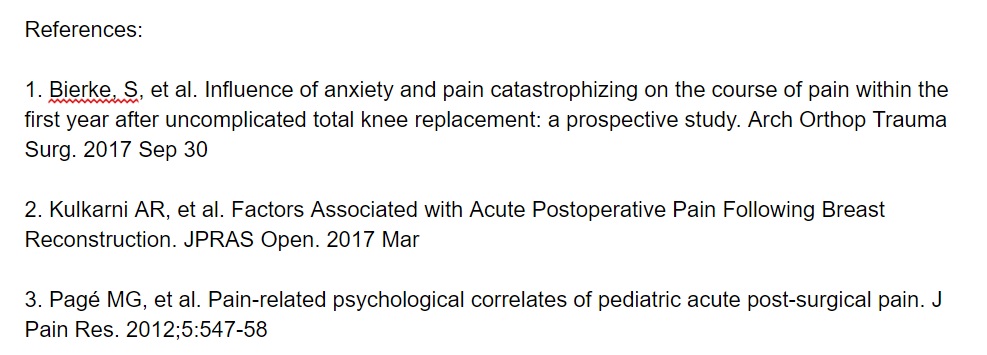NM-256
The effect of patient and parental psychosocial risk factors on postoperative pain scores and opioid use: a pilot study
Jiao Y, Juriga L, Sharma A
Washington University in Saint Louis, Saint Louis, MO, United states
Introduction: Contemporary theories suggest that psychological and social aspects play a key role in the perception of pain. Preoperative anxiety and pain catastrophizing have been associated with more pain and lower function in adults (1,2). These factors have also been implicated in children although the data is limited (3). The effect of parental attitude in children is unclear. We present preliminary data from post-hoc analysis comparing preoperative patient and parental psychosocial risk factors with postoperative pain scores and opioid consumption.
Methods: Our study is a secondary analysis of a randomized controlled trial studying the effective methadone dose for patients undergoing posterior spinal fusion (PSF). Patients were considered eligible if they were ages 11-18, ASA 1 or 2 undergoing PSF for idiopathic scoliosis. Preoperatively, patients were given a PROMIS questionnaire quantifying putative risk factors in six categories: pain interference with daily activities, physical mobility, fatigue, depression, anxiety, and peer relationships. Parents were also given a questionnaire quantifying putative risk factors in two categories: emotional distress and perception of their child’s pain. All data was collected on a five point Likert scale. All opioid use during the hospital stay was recorded. A numerical pain rating score was recorded on each postoperative day.
Results: Results: A total of 39 patients were surveyed. Three patients were excluded for protocol violation, resulting in 36 patients and parents available for our analysis. Ten patients endorsed symptoms of depression at least “sometimes†while 3 patients endorsed symptoms “often†or “almost all the timeâ€. Fifteen patients endorsed symptoms of anxiety at least “sometimes†while 9 endorsed symptoms “often†or “almost all the timeâ€. Seven parents endorsed emotional distress at least “sometimesâ€. Twelve parents felt their child had functional difficulty as a result of pain “often†or “almost always†. Mean overall pain score was 4.5 (SD 2.1). Mean total opioid use was 2.66 mg/kg morphine equivalent (SD 0.84 mg/kg).
Discussion: These preliminary data show that a substantial fraction of patients and parents of patients undergoing PSF endorse feelings of anxiety or emotional distress which may account for variability in postoperative opioid consumption. Our next step is to perform a multivariate analysis of our pilot data to characterize this relationship, which we intend to present with our data. By better elucidating patient and parental factors that influence pain perception and opioid consumption, we hope to inform future practice decisions that increase patient satisfaction and minimize opioid-related morbidity.
Conclusion: We present preliminary data evaluating the effect of preoperative patient and parental psychosocial risk factors with postoperative pain and opioid use.
Top












